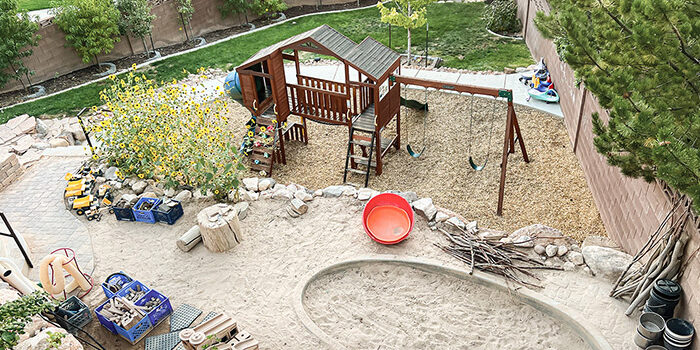Have you ever wondered what it takes to provide high-quality child care from home, especially in rural areas? For family child care (FCC) educators like Terry Whitworth from North Carolina, Kristy DeGraaf from Utah, and Melissa Rudack from Wisconsin, it’s more than just having a safe space and a loving heart; it’s about constantly navigating the challenges of maintaining and improving their facilities to meet the needs of the children and families they serve. And, as we’ve recently discovered, these challenges often come with a hefty price tag.
According to a recent survey, 26% of home-based child care providers report struggling to cover housing expenses. This struggle is even more pronounced for educators in rural communities, where access to resources and funding can be limited. That’s why the National Association for Family Child Care (NAFCC) set out to understand these challenges and find out what’s working to secure funding for much-needed facility improvements.
Digging into the Challenges
We began by speaking with three dedicated FCC educators. Each had recently navigated the complicated maze of funding to make significant improvements to their homes. Their stories were eye-opening. From high construction costs to unexpected expenses tied to improving their property or grounds, these educators faced barriers that seemed insurmountable. Yet, they pushed forward, driven by their commitment to providing a nurturing environment for the children in their care.
One of the most common issues they faced was the high costs associated with property improvements. Whether renovating an outdoor play area, installing new windows, or upgrading heating and cooling systems to make their spaces more comfortable year-round, the price tags were daunting. Many of these providers emphasized the need for substantial and sustained funding to make the necessary, permanent upgrades that would improve safety and enhance the learning environment.
Celebrating Funding Successes
But here’s the good news: despite the challenges, some educators have found creative solutions and secured funding to transform their child care spaces. For example, Terry Whitworth (North Carolina) used state grants to renovate her facility, making it safer and more functional. Her renovations included custom-built playground equipment, new windows to brighten the space, and a separate entry door for the child care area to enhance security and convenience. You can hear more about Terry’s journey here.
Similarly, Kristy DeGraaf (Utah) utilized grant funding to upgrade her outdoor learning center, enhance walkways, and add permanent fencing, ensuring children could explore and play safely. Discover how Kristy made these improvements here.
Meanwhile, Melissa Rudack (Wisconsin) tapped into public funds to make crucial upgrades to her child care home, enhancing both functionality and safety. Learn more about Melissa’s funding success and the changes she implemented here.
What We Learned: Key Takeaways
- Increase Access to Funding: There is a clear need to expand access to public and private funding specifically targeted at facility improvements for family child care (FCC) educators. More opportunities for grants and financial support will enable educators to create safe, nurturing spaces that foster growth and learning for children.
- Provide Training and Resources: Educators must be equipped with the tools and knowledge to navigate the often complex funding process. Many providers are unsure where to begin when applying for grants or managing funds, so offering targeted training on these topics is essential.
- Address Unique Needs for Home-Like Environments: FCC educators have distinct needs in creating a home-like environment that ensures safety and nurtures children’s development. All modifications must comply with licensing requirements, and the NAFCC’s Accreditation Standards can serve as a guide for best practices in home-based settings. For instance, educators like Terry Whitworth, who operates a 24-hour program, require secure doors and other safety measures tailored to their unique circumstances.
- Consider Renovation and Financing Concerns: Since facility improvements often occur in the provider’s living space, there are specific concerns about the logistics and financing of renovations. These challenges are even more complicated for those who do not own the property, highlighting the need for clear guidance and support.
- Advocate for Environment Resilient Policies: It is crucial to advocate for policies that help child care facilities withstand extreme weather events and other challenges that may compromise safety and operations. Rural communities, in particular, would greatly benefit from policies designed to support the resilience of these vital child care spaces.
Looking Ahead: A Call to Action
As we look to the future, it’s clear that addressing the facility needs of home-based child care providers in rural communities isn’t just about fixing a roof or adding a new door. It’s about ensuring that every child has access to a high-quality, safe, and nurturing environment that supports their development. By implementing these recommendations and learning from the successes of those who have navigated these challenges, we can help more providers overcome the obstacles they face.
So, let’s celebrate these successes, advocate for more funding, and continue to support the incredible educators who open their homes and hearts to children every day. Because when we invest in them, we’re investing in a brighter future for us all.
Want to learn more about how we can support family child care educators?
Check out these resources:
NAFCC Leadership Report: https://nafcc.org/docs/Leadership-Report.pdf
NAFCC Action Center: https://nafcc.org/act-now/






